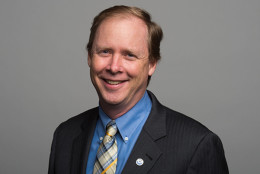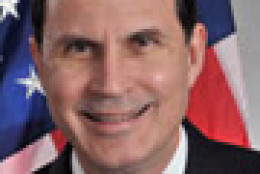National Oceanic and Atmospheric Administration
-
It's hard to forget the videos of oil spewing forth from the hole at the bottom of the Gulf of Mexico. The Deepwater Horizon accident took 87 days to cap off. But it will take thousands and thousands of days to totally clean up. The job of overseeing what might be a 15-year effort belongs to Christopher Doley, chief of habitat restoration at the National Oceanic and Atmospheric Administration. He's also a finalist for this year's Service to America Medals. He spoke to Federal Drive with Tom Temin about the cleanup effort.
May 27, 2016 -
Federal agencies are experimenting with different ways of incorporating mobile data into their missions: some are trying to protect citizens' data, while others are recruiting volunteers to collect and share more.
April 26, 2016 -
The DATA Act will usher in a new way of reporting federal spending information, but information systems officials say it's also time to revisit job descriptions for data experts.
April 21, 2016 -
Robert Bunge, Michael Gerber and the Wireless Alerts Team developed the Wireless Emergency Alerts system, which has sent our over 15,000 warnings since it was implemented in 2012.
September 04, 2015 -
The Western states are experiencing an historic drought. But a strong El Niño is building in the Pacific. Forecast models predict a strong event. That raises several questions. Will the rain bring relief or devasting floods and mudslides? Will it come at all? How soon can the government predict the effects of this year's storm so agencies and citizens can prepare? For answers, we turn to Mike Halpert, Deputy Director of the National Oceanic and Atmospheric Administration’s Climate Prediction Center in College Park. He spoke with Tom Temin on the Federal Drive for an inside look at El Niño forecasting.
July 28, 2015 -
The National Weather Service can now pinpoint the exact location where a storm might hit, and send an emergency message to the people who might be affected on their cell phones. Michael Gerber is a meteorologist at the National Weather Service, and a member of the Wireless Emergency Alerts Team. He and three of his colleagues are finalists for a Service to America medal in the homeland security and law enforcement category. He tells In Depth with Francis Rose how the new weather alert systems are different from the old ones.
June 11, 2015 -
The General Services Administration and the National Oceanic and Atmospheric Administration plan to release major IT and services solicitations in the coming month. The draft RFPs are part of the broader effort to change the government's approach to acquisition.
February 20, 2015 -
With the help of higher resolution modeling systems, less disruption to daily life and the economy occurred than otherwise might have when hurricane Arthur made landfall last year. That's thanks to a highly accurate landfall prediction made possible by supercomputers. This month, the National Oceanic and Atmospheric Administration begins the next phase of a $44.5 million upgrade to its supercomputers. Dr. Louis Uccellini is director of the National Weather Service at NOAA. He joined the Federal Drive with Tom Temin to explain the strategy behind NOAA's newest upgrade.
January 19, 2015 -
Mark Doms, the Commerce Department's undersecretary for Economic Affairs, said the agency is hiring a chief data officer, setting up a Data Advisory Council and looking to private sector experts to make its information more accessible and easier to use. Commerce also is testing mapping and other tools to improve the presentation of data.
November 11, 2014 -
The new Chief Information Officer at the Justice Department is reviewing his to-do list two months into the job. Joe Klimavicz took over as the Justice CIO in May after leaving the National Oceanic and Atmospheric Administration. Joe writes about his first weeks on the job on the CIO Council's blog. He says he had to dig in quickly and learn the ropes at DoJ.
July 24, 2014 -
NOAA planes used for tracking and forecasting hurricanes -- known as the P-3 Orion -- are reaching the end of their lifespan, according to a report published by the Government Accountability Office.
July 16, 2014 -
The National Weather Service is recruiting federal agencies to be ambassadors as part of its Weather-Ready Nation initiative. NWS says ambassadors are helping citizens and businesses prepare for weather emergencies. Laura Furgione, deputy director for the National Weather Service, tells Federal News Radio's Executive Editor Jason Miller about the new ambassadors program and how agencies can get involved. Read Jason's related article.
June 17, 2014 -
One of the most damaging aspects of hurricanes is not the storm itself — it is what happens afterwards. Both Hurricane Katrina and Superstorm Sandy showed communities were not prepared for the storm surges and flooding. This hurricane season, the National Oceanic and Atmospheric Administration is rolling out new tools to improve forecasts and communication. James Franklin is the branch chief in NOAA's hurricane specialist unit. He joined Tom Temin and Emily Kopp on the Federal Drive from the National Hurricane Center.
June 13, 2014 -
Federal scientists hope to get the first inside look at hurricanes, thanks to new drones. This hurricane season the National Hurricane Center in Miami will send small-unmanned aircraft into the eyes of the storms. Joe Cione is a hurricane researcher at the center, which is part of the National Oceanic and Atmospheric Administration. He joined Tom Temin and Emily Kopp on the Federal Drive to discuss what scientists hope to accomplish.
May 30, 2014 -
The White House recently put out what it calls "the loudest and clearest alarm bell to date" on climate change. Its new report says global warming is a factor in changing weather from heat waves to bad allergy seasons. Much of the data supplying the national climate debate is housed by the National Oceanic and Atmospheric Administration. Tom Karl, director of NOAA's National Climatic Data Center, spoke with Federal Drive hosts Tom Temin and Emily Kopp about the work his agency is conducting and the data its collecting.
May 13, 2014














